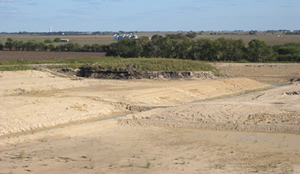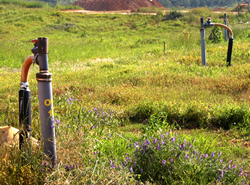Expansion
In the mid-1990s, Williamson County purchased additional acreage around the existing landfill for the express purpose of expanding the landfill to meet the waste needs of the growing population in Williamson County.
During the last three years alone, the population has grown by nearly 22 percent. Leander, Cedar Park, Round Rock and Georgetown are among the top 100 fastest-growing cities in the United States.
The Williamson County Commissioners responded to the extensive growth in the region and passed a resolution in 2002 supporting an expansion of the landfill to ensure long-term, environmentally safe waste disposal for its residents and businesses. Click here for a Landfill Map that shows the current footprint and expansion.
As a result, the County instructed Waste Management to prepare a land use application (Parts 1 & 2), the first step in the permit process with the Texas Commission on Environmental Quality (TCEQ). Filed in July 2003, the application called for an additional landfill footprint that combined with the capacity of the current permitted landfill is projected to provide more than 45 years of additional capacity, based on population growth forecasts and expected volumes.
The TCEQ held a public meeting on October 11, 2004 to hear public comments on the expansion application (Parts 1 & 2). In January 2005, the TCEQ provided responses to the public comments and determined the permit application (Parts 1 & 2) “meets the requirements of applicable law.”
In late December 2004, Waste Management filed the technical parts (Parts 3 & 4) of the application with the TCEQ. In response to public comments in support of combining the land use and technical portions of the application, Williamson County and Waste Management have requested that the TCEQ process Parts 3 & 4 of the application as a major amendment to Parts 1 & 2, thereby consolidating the application.

In 2006, the TCEQ deemed the application for the landfill expansion to be both "administratively complete" and "technically complete." The TCEQ held another public meeting in July 2006 to accept public comments. The application was then referred to the State Office of Administrative Hearings (SOAH) where issues concerning the expansion permit are examined by an administrative law judge. The administrative law judge recommended that the landfill expansion proceed. On February 11, 2009, the Texas Commission on Environmental Quality voted to issue the permit enabling the County to move forward with expansion plans.
Below are specifics related to the technical parts of the application in regards to groundwater monitoring, storm water management, gas collection and extraction, and other operating procedures.
- The landfill will change from 202 permitted acres (with a current landfill footprint of approximately 160 acres) to approximately 575 permitted acres (with a total landfill footprint of approximately 423 acres). The expansion footprint is approximately 263 acres (less than the previous estimate of 342 acres given additional buffer and the addition of three storm water detention ponds).
- By regulation, the buffer area between the landfill footprint and the property boundary is required to be a minimum of 50 feet. However, the technical portion of the landfill application proposes buffer areas that range from at least 50 feet to as much as 400 feet in some areas.
- To protect groundwater, the final proposed permanent groundwater monitoring network will consist of approximately 35 groundwater monitoring wells located along the perimeter of the landfill. The landfill currently has eight groundwater monitoring wells.
- To manage storm water discharge, the landfill will add a total of three large storm water detention ponds. Other storm water management controls include drainage terraces, approximately 10 culverts and rock dams.
- The final height of the landfill would increase by 74 feet from the current permitted height of 70 feet above ground. The TCEQ rules require that landfills maintain sufficient slope to promote drainage for proper management and control of storm water runoff. To meet this requirement, the top of the landfill with the expansion would slope down gradually from the maximum height such that the average height of the landfill would be around 100 feet above ground.
- To continue to protect the environment, waste will not be deposited in the 100-year flood zone or Mustang Creek.

- To minimize landfill gas emissions and control potential odors, the landfill will install an active gas collection and extraction system. This type of system collects, removes and destroys landfill gas via a central, high-temperature flare.
- To protect against off-site migration of landfill gas, a total of 27 gas monitoring probes will be placed around the perimeter of the facility. (Currently, there are 22 gas probes in place; 12 probes will be added and 7 existing probes will be removed as areas are filled.)
- The landfill will continue to build a liner system that consists of at least a two-foot layer of low-permeability, re-compacted clay soil, covered by a continuous 60-mil, high-density polyethylene (HDPE) secondary plastic liner installed to cover the entire bottom and sides of the landfill cell.
- The landfill will continue to build and operate a leachate collection system over the liner system to capture liquids that come in contact with the trash for treatment and proper disposal. (Leachate is liquids generated from rainfall and the natural decomposition of waste.)
- The landfill will pick up litter daily along FM 1660 and County Road 130, within two miles of the landfill entrance.
The expansion and continued operation of the Williamson County Landfill provide the following benefits:
- The expansion is on property already owned by Williamson County and is an appropriate land use for this property.
- The TCEQ permit process is comprehensive and invites public participation.
- The vast majority of the municipal solid waste disposed at the Williamson County Landfill originates from Williamson County.
- The Williamson County Landfill is also economically beneficial for the community and its customers.
- The Williamson County Landfill provides not only environmentally safe waste disposal for customers, but also is a convenient, affordable and competitive option for both large and small businesses and residents.
